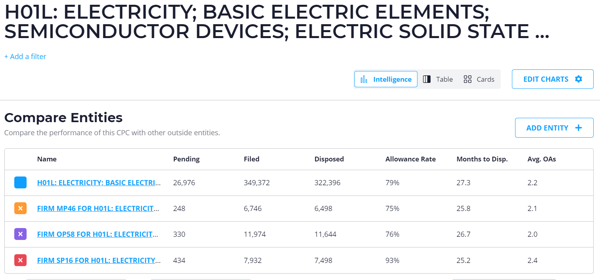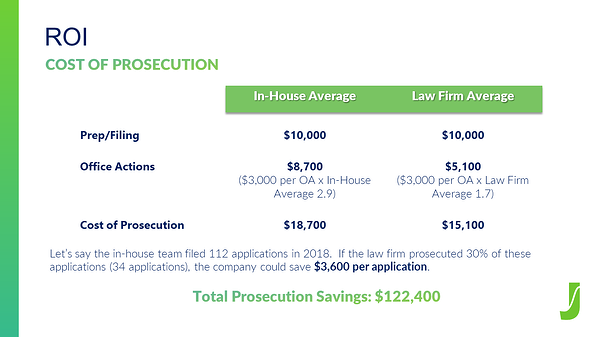IP firms are taking some time to reflect on the current state of their profit margins. Our conversations with clients have made it clear: business development is a top priority.
When it comes to winning new clients, the best way to stand out from the competition is with persuasive metrics. A blend of the tried-and-true basics (such as allowance rate and average months to allowance) and more complex data points (like the ROI of your work) can help your team customize your marketing efforts and expand your book of business.
These metrics - ranging from fundamental to more advanced - can help take your marketing to the next level.
The fundamentals
These fundamental metrics are a great place to start in your negotiations.
- Companies are looking for firms that can successfully grow their patent portfolio in a timely and inexpensive manner. Your firm’s allowance rate is a big selling point here (and we will show how you can turn that number into quantifiable ROI in a later section).
- Don’t forget to highlight measurements of speed. Compare your average months to disposition for an allowance to competitors to show how quickly your team moves through the review process, and demonstrate your cost-savings focus with your average number of OAs to allowance.
- A high filing volume in a certain technology area can prove your firm’s expertise. By looking into the primary technology area of a potential client, you can show how your firm is very familiar with prosecuting similar technologies at the USPTO.
- Companies want to maintain as much of the original scope of a patent application as possible. With tools like Juristat Analytics, you can calculate the average change in independent and dependent claims in applications represented by your firm. With a low average change in claims, your firm demonstrates an ability to protect the original intent and integrity of patent applications under your watch.
- Extensions are yet another added expense that slow down a prosecution. A low extension percentage (the percentage of rejections followed by a request for extension) can indicate a firm’s attentiveness and timeliness in prosecution.
Comparative metrics
With technology today, you can compare your firm’s success rate to averages at the USPTO, in a specific technology grouping at the USPTO, and even at competing firms. Show how your firm is the best of all available options!
For example, let’s say your prospective client has a high filing volume in CPC Class H01L (basic electric elements and semiconductor devices). With access to patent analytics tools like Juristat, your firm can pull the benchmark data for that specific class and compare those numbers to the success rate of your firm, your competitors, and even the in-house team of the prospect company.
As an example, we’ve pulled this comparison chart for CPC Class H01L directly from Juristat. We’ve hidden the firm names, but you can see how easy it is to get a side-by-side comparison of multiple entities.

By comparing the allowance rate, average months to allowance, and average number of OAs of different entities in an easy-to-read chart, you can illustrate what makes your firm stand out from the pack. Shape your messaging around those fundamental metrics once you’re aware of what technology areas are essential to their bottom line.
Firm ROI
One way to strengthen relationships with current clients is to use prosecution data to quantify your firm’s ROI. Communicating the exact dollar value of your work can lead to more trust in existing relationships, but you can also calculate similar numbers to persuade new clients. In fact, it should be a central part of any pitch for new business.
Here are two ways to highlight firm ROI:
Use average office actions to show prosecution savings
Fewer office actions tend to lead to a faster and less expensive prosecution. Tying that theory to hard data and translating it directly into cost savings can have a huge impact during your sales negotiations.
Let’s say, for example, your firm is trying to convince a potential client to hire your team instead of moving their patent work in-house. First, take into consideration the initial preparation and filing of an application. Here, we’re assuming that cost is $10,000, based on the AIPLA’s 2015 Report of the Economic Survey for an original, relatively complex application dealing with computers or electronics. We’re also assuming the cost for each office action is $3,000.

This is where business intelligence data from Juristat comes in handy. Using analytics, your firm could easily compare your (superior!) OA track record to that of the company’s in-house team or even competing outside counsel.
After a few simple calculations, you can put a dollar amount on the value of your firm’s services. In this example, we see that by diverting 30% of the company’s applications to this law firm rather than prosecuting in-house, the potential prosecution savings are $122,400.
Show how allowance rate can increase portfolio value
Allowance rate isn’t the only way to quantify firm success, but it is an effective one. And showing how your firm’s superior allowance rate could increase the value of the client’s patent portfolio could be a game-changer in contract negotiations.
Continuing the same example as above, we’re also able to show how your firm’s superior allowance rate could increase the value of the company’s patent portfolio.

With patent analytics, you’re able to compare your firm’s allowance rate with the client’s in-house team or competing outside counsel. You can then calculate how many additional allowed applications your firm could gain the new client.
In this example, we see that by diverting 30% of the company’s applications to this law firm rather than prosecuting in-house, the client is potentially increasing the value of their portfolio by $150,000 (assuming the value of a single patent is $25,000).
Whether you're evaluating your own team's performance, preparing a client pitch, or looking for that next big client to add to your roster, patent analytics can transform your practice. Juristat combines business development and competitive intelligence in one powerful tool with access to your own performance metrics and those of every firm and company filing at the USPTO. And the law firms that leverage relevant and specific data in their business development strategy are better positioned to win over new clients.
Looking for ways to integrate more data into your business development? Let’s find a time to talk.
(gradient).webp)
-1.jpeg)
